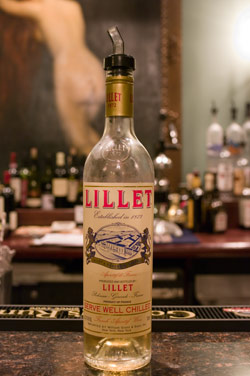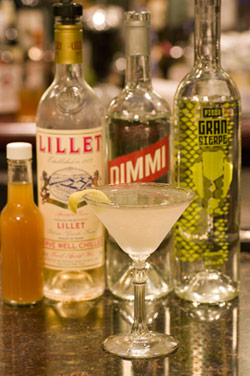 The original Lillet Blanc recipe dates back to 1872 and was called Kina Lillet made by Paul and Raymond Lillet. In 1986 it was reformulated. The recipe cut back on the quinine/bitterness and added more fresh fruit notes. Kina in the original name comes from the Peruvian tree called “kina kina”. They use the bark of this tree to make quinine, also called Chinchona.
The original Lillet Blanc recipe dates back to 1872 and was called Kina Lillet made by Paul and Raymond Lillet. In 1986 it was reformulated. The recipe cut back on the quinine/bitterness and added more fresh fruit notes. Kina in the original name comes from the Peruvian tree called “kina kina”. They use the bark of this tree to make quinine, also called Chinchona.
Tasting notes: Sniff and you’ll notice the select blend of Bordeaux grapes aged in oak casks, followed by a strong orange aroma with a touch of floral. Lillet Blanc goes down sweet with honey and candied orange followed by a nice cleansing floral and mint flavor. The finish is bitter with pine resin and lingers with honey and fresh citrus.
This is a French aperitif wine, but could be substituted for dry vermouth in your cocktail of choice. Treat it like a white wine and keep it cold and vacuum pumped. I would use this up in a month, after that the flavors will go flat. Most bars don’t take proper care of their vermouths and that’s why a lot martinis are made without vermouth and get a bad wrap. It’s great for contemporary cocktail creations and I find myself using it in a lot of my recipes, it’s that good.
$15 a bottle
Here’s a Post Prohibition original and a classic cocktail recipe using Lillet Blanc:
Culture Club

- 2 oz Dimmi Liquore Di Milano
- 1 oz Pisco Gran Sierpe
- 1/2 oz Lillet Blanc
- Couple dashes orange bitters
Stir cocktail with ice and strain into a chilled cocktail glass.
Garnish with a lemon twist.
Corpse Reviver #2
- 1 oz gin
- 3/4 oz Cointreau
- 3/4 oz Lillet Blanc
- 3/4 oz fresh lemon juice
- 3 drops of absinthe
- 1 stemless cherry
Shake all ingredients except the cherry and then strain into a chilled cocktail glass.
Garnish with a stemless cherry.
Here are some more recipes with Lillet Blanc.